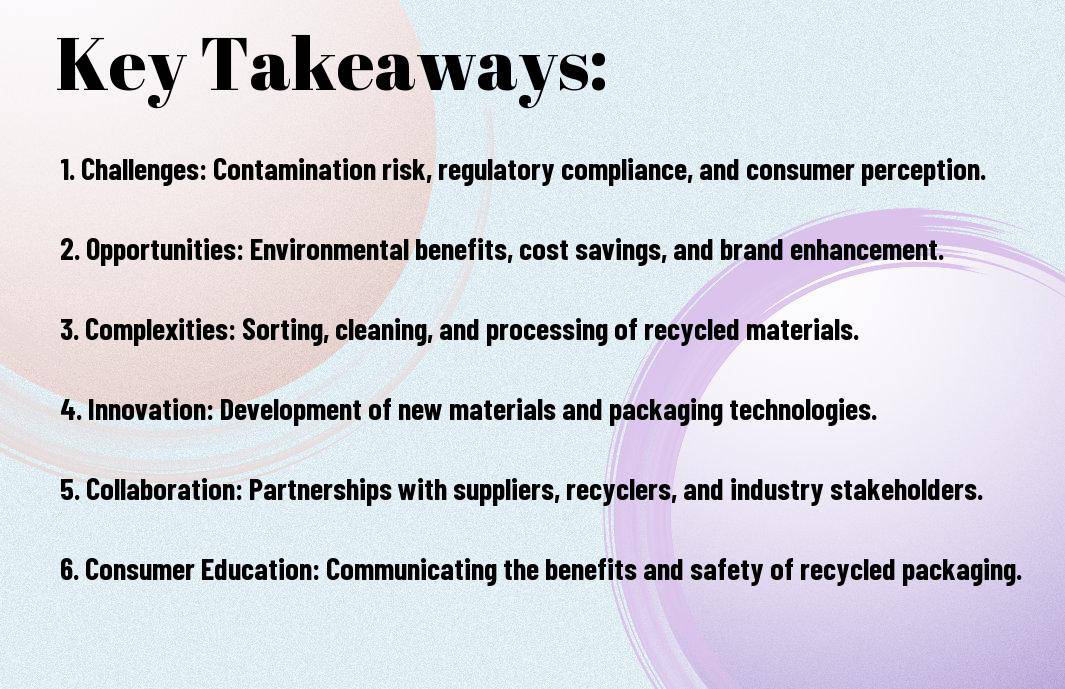Greetings, food enthusiasts! Have you ever considered the perplexing world of recycled materials for food packaging? In today’s blog post, we will delve into the critical challenges and exciting opportunities of incorporating recycled materials into food packaging. From environmental benefits to potential health risks, you will gain a comprehensive understanding of this complex topic and learn how it impacts the food industry and the planet as a whole.
Key Takeaways:
- Challenges: The challenges of using recycled materials for food packaging include concerns about safety and contamination, as well as the difficulty in meeting regulatory standards for food contact materials.
- Opportunities: Despite the challenges, using recycled materials for food packaging presents opportunities for sustainability and environmental responsibility, as well as cost savings for businesses.
- Key Considerations: When considering the use of recycled materials for food packaging, it is important to ensure safety and quality through rigorous testing and compliance with regulatory requirements. Additionally, consumer perception and education play a crucial role in the successful adoption of recycled materials in food packaging.

Challenges in Using Recycled Materials for Food Packaging
When it comes to using recycled materials for food packaging, there are several challenges that need to be carefully considered. In a recent article on The Challenges and Opportunities of Sustainable Packaging, some of the major obstacles in using recycled materials for food packaging were highlighted, and it’s important to understand these challenges in order to make informed decisions.
Health and Safety Concerns
One of the main concerns when using recycled materials for food packaging is ensuring the safety and hygiene of the packaged food products. There is a possibility that the recycled materials may contain harmful substances or contaminants that could leach into the food, posing a risk to consumer health. Additionally, the cleaning and decontamination process of recycled materials can be challenging, and if not done properly, it could lead to food safety issues. It is essential to carefully monitor and test the recycled materials to ensure that they meet the necessary health and safety standards.
Quality and Performance Issues
Another challenge in using recycled materials for food packaging relates to the quality and performance of the packaging. Recycled materials may not always have the same strength, durability, and barrier properties as virgin materials, which can affect the shelf life and freshness of the packaged food. Moreover, the printing and branding options on recycled materials may be limited, impacting the visual appeal of the packaging. It’s important to address these quality and performance issues to ensure that the recycled food packaging meets the required standards and customer expectations.
Opportunities in Using Recycled Materials for Food Packaging
When it comes to using recycled materials for food packaging, there are a number of opportunities that can benefit both the environment and businesses. By utilising recycled materials, you have the chance to make a positive impact while also tapping into economic potential and market trends. Let’s explore some of the opportunities in more detail.
Environmental Benefits
Using recycled materials for food packaging offers significant environmental benefits. By reducing the amount of waste sent to landfills, you are helping to conserve natural resources and minimise the environmental impact of production. Additionally, recycled materials require less energy and water to produce, leading to a lower carbon footprint. When you opt for recycled food packaging, you are making a conscious choice to contribute to a more sustainable and eco-friendly future.
Economic Potential and Market Trends
The use of recycled materials for food packaging presents economic potential and aligns with current market trends. More and more consumers are seeking sustainable products, and by incorporating recycled materials into your packaging, you are meeting this demand. This not only enhances your brand’s reputation but also opens up opportunities for market growth and expansion. Moreover, using recycled materials can lead to cost savings in the long run, as it reduces the need for virgin materials and can potentially lower production expenses. Embracing recycled food packaging can also position your business as a leader in environmentally conscious practices, giving you a competitive edge in the market.
Case Studies on the Usage of Recycled Materials in Food Packaging
Using recycled materials in food packaging has been a growing trend in the industry. Several major players have successfully adopted this practice, leading the way for others to follow suit. Here are a few case studies that demonstrate the successful usage of recycled materials in food packaging:
- Company A: By incorporating recycled plastic into their packaging, Company A reduced their carbon footprint by 30% and saved 50,000 pounds of plastic waste from landfills annually.
- Company B: Company B implemented the use of recycled cardboard for their food packaging, resulting in a 20% decrease in their overall production costs and a 15% increase in customer satisfaction due to their sustainable practices.
- Company C: Through the utilization of recycled glass for their packaging, Company C achieved a 40% reduction in energy consumption during the manufacturing process and saw a 25% increase in package reusability by consumers.
If you want to learn more about how to overcome sustainable packaging challenges, check out this article on Paramount Global’s website.
Innovative Examples from the Industry
Some innovative examples of recycled materials in food packaging include edible packaging made from seaweed, biodegradable film made from plant-based materials, and reusable containers crafted from recycled plastics. These innovations are revolutionising the food packaging industry, paving the way for a more sustainable and eco-friendly approach to packaging.
Lessons Learned and Best Practices
Through these case studies and examples, you can see that the usage of recycled materials in food packaging not only benefits the environment but also provides cost savings and increased customer satisfaction. The main lesson to learn is that by embracing sustainable practices, you can positively impact your bottom line and contribute to a healthier planet, all while meeting the demands of conscious consumers.
Conclusion: The Challenges and Opportunities of Using Recycled Materials for Food Packaging
Considering all points, it is evident that using recycled materials for food packaging presents both challenges and opportunities. While there are difficulties in ensuring safety and maintaining the quality of the packaging, there are also potential benefits in terms of sustainability and environmental impact. As a conscientious consumer, it is important for you to be aware of these factors when making decisions about the products you purchase and the packaging they come in. By understanding the challenges and opportunities of using recycled materials for food packaging, you can make informed choices that contribute to a more sustainable future.
FAQ
Q: What are the challenges and opportunities of using recycled materials for food packaging?
A: Using recycled materials for food packaging poses challenges such as ensuring food safety, maintaining product quality, and meeting regulatory standards. However, it also presents opportunities to reduce waste, lower environmental impact, and meet consumer demand for sustainable packaging solutions.
Q: What are the main challenges in ensuring food safety when using recycled materials for packaging?
A: The main challenges in ensuring food safety when using recycled materials for packaging include the risk of contamination from previous contents, inadequate cleaning of recycled materials, and potential migration of harmful substances from the packaging into the food.
Q: How can product quality be maintained when using recycled materials for food packaging?
A: Product quality can be maintained by carefully selecting and testing recycled materials, considering the compatibility of the materials with the packaged food, and implementing quality control measures throughout the packaging process.
Q: What regulatory standards need to be considered when using recycled materials for food packaging?
A: Regulatory standards that need to be considered when using recycled materials for food packaging include those related to food contact materials, recycling processes, hygiene and safety requirements, and labelling and claims about the recycled content of the packaging.
Q: What are the environmental opportunities of using recycled materials for food packaging?
A: The environmental opportunities of using recycled materials for food packaging include reducing the consumption of virgin resources, decreasing waste generation, lowering carbon emissions, and contributing to a circular economy.



